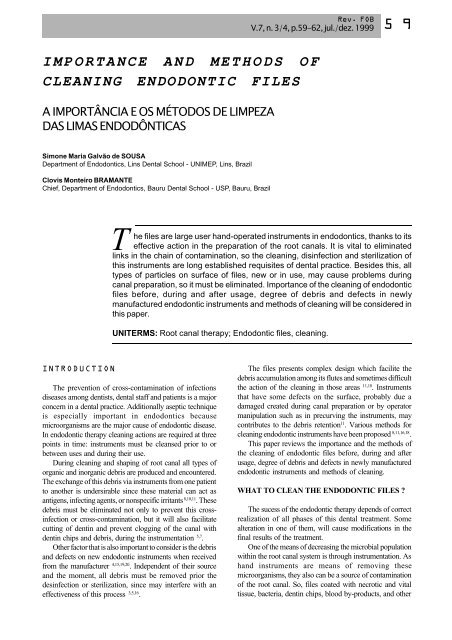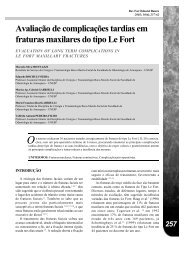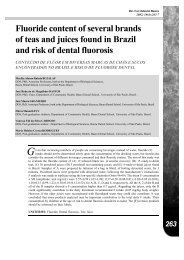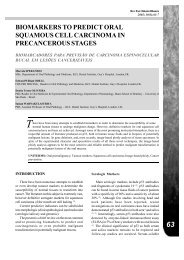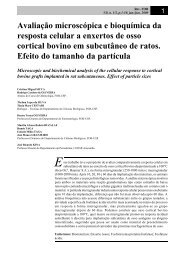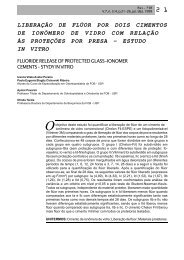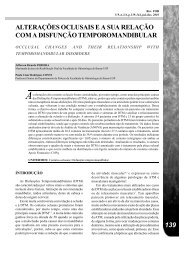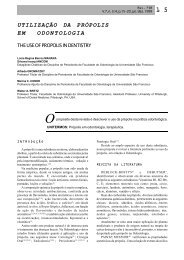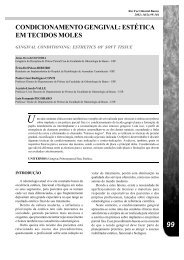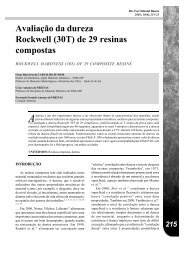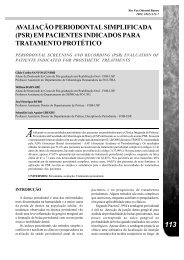IMPORTANCE AND METHODS OF CLEANING ENDODONTIC FILES
IMPORTANCE AND METHODS OF CLEANING ENDODONTIC FILES
IMPORTANCE AND METHODS OF CLEANING ENDODONTIC FILES
You also want an ePaper? Increase the reach of your titles
YUMPU automatically turns print PDFs into web optimized ePapers that Google loves.
Rev. FOB<br />
V.7, n. 3/4, p.59-62, jul./dez. 1999<br />
5 9<br />
<strong>IMPORTANCE</strong> <strong>AND</strong> <strong>METHODS</strong> <strong>OF</strong><br />
<strong>CLEANING</strong> <strong>ENDODONTIC</strong> <strong>FILES</strong><br />
A IMPORTÂNCIA E OS MÉTODOS DE LIMPEZA<br />
DAS LIMAS ENDODÔNTICAS<br />
Simone Maria Galvão de SOUSA<br />
Department of Endodontics, Lins Dental School - UNIMEP, Lins, Brazil<br />
Clovis Monteiro BRAMANTE<br />
Chief, Department of Endodontics, Bauru Dental School - USP, Bauru, Brazil<br />
T<br />
he files are large user hand-operated instruments in endodontics, thanks to its<br />
effective action in the preparation of the root canals. It is vital to eliminated<br />
links in the chain of contamination, so the cleaning, disinfection and sterilization of<br />
this instruments are long established requisites of dental practice. Besides this, all<br />
types of particles on surface of files, new or in use, may cause problems during<br />
canal preparation, so it must be eliminated. Importance of the cleaning of endodontic<br />
files before, during and after usage, degree of debris and defects in newly<br />
manufactured endodontic instruments and methods of cleaning will be considered in<br />
this paper.<br />
UNITERMS: Root canal therapy; Endodontic files, cleaning.<br />
INTRODUCTION<br />
The prevention of cross-contamination of infections<br />
diseases among dentists, dental staff and patients is a major<br />
concern in a dental practice. Additionally aseptic technique<br />
is especially important in endodontics because<br />
microorganisms are the major cause of endodontic disease.<br />
In endodontic therapy cleaning actions are required at three<br />
points in time: instruments must be cleansed prior to or<br />
between uses and during their use.<br />
During cleaning and shaping of root canal all types of<br />
organic and inorganic debris are produced and encountered.<br />
The exchange of this debris via instruments from one patient<br />
to another is undersirable since these material can act as<br />
antigens, infecting agents, or nonspecific irritants 8,10,11 . These<br />
debris must be eliminated not only to prevent this crossinfection<br />
or cross-contamination, but it will also facilitate<br />
cutting of dentin and prevent clogging of the canal with<br />
dentin chips and debris, during the instrumentation 5,7 .<br />
Other factor that is also important to consider is the debris<br />
and defects on new endodontic instruments when received<br />
from the manufacturer 4,15,19,20 . Independent of their source<br />
and the moment, all debris must be removed prior the<br />
desinfection or sterilization, since may interfere with an<br />
effectiveness of this process 3,5,16 .<br />
The files presents complex design which facilite the<br />
debris accumulation among its flutes and sometimes difficult<br />
the action of the cleaning in those areas 11,18 . Instruments<br />
that have some defects on the surface, probably due a<br />
damaged created during canal preparation or by operator<br />
manipulation such as in precurving the instruments, may<br />
contributes to the debris retention 11 . Various methods for<br />
cleaning endodontic instruments have been proposed 8,11,16,18 .<br />
This paper reviews the importance and the methods of<br />
the cleaning of endodontic files before, during and after<br />
usage, degree of debris and defects in newly manufactured<br />
endodontic instruments and methods of cleaning.<br />
WHAT TO CLEAN THE <strong>ENDODONTIC</strong> <strong>FILES</strong> <br />
The sucess of the endodontic therapy depends of correct<br />
realization of all phases of this dental treatment. Some<br />
alteration in one of them, will cause modifications in the<br />
final results of the treatment.<br />
One of the means of decreasing the microbial population<br />
within the root canal system is through instrumentation. As<br />
hand instruments are means of removing these<br />
microorganisms, they also can be a source of contamination<br />
of the root canal. So, files coated with necrotic and vital<br />
tissue, bacteria, dentin chips, blood by-products, and other
60<br />
SOUSA, S. M. G. de; BRAMANTE, C. M.<br />
<strong>IMPORTANCE</strong> <strong>AND</strong> <strong>METHODS</strong> <strong>OF</strong> <strong>CLEANING</strong> <strong>ENDODONTIC</strong> <strong>FILES</strong><br />
potential irritants will be ignored. Besides this, soiled or<br />
heavily contamined instruments may present a challenge to<br />
all practical methods of sterilization or desinfection, therefore<br />
difficult to prevent cross-infection.<br />
One of the causes of root canal treatment failures is<br />
associated with underextended obturations commoly<br />
combined with a debris-land root apex. According to<br />
SOMMER; OSTR<strong>AND</strong>ER; CROWLER 15 , at no time<br />
should a dentin laden file be allowed to re-enter the canal.<br />
Also, we can’t forget the action of the irrigants solutions<br />
upon the files. The irrigants employed during the therapy<br />
cause alterations on the metalic structure of the stainless<br />
steel instruments 12 . The cleaning should be done as soon as<br />
possible after use or repeatedly during the endodontic<br />
practice.<br />
· Importance to cleaning the files before use<br />
Some studies has been discussion concerning the<br />
presence of debris and metallic defects on the surfaces of<br />
newly endodontic files and reamers 11,15,19,20 . These<br />
impurities, some of them, lost from the metallic surface of<br />
the files during instrumentation, may preclude untwisting<br />
of the instruments or blockage the canal.<br />
SEGALL et al. 13 have shown that different endodontic<br />
instruments from three different manufacturers have foam<br />
rubber, plastic from handle, colloidal debris, a grease or oil<br />
film, epithelial cells and metal spurs, within their flutes.<br />
Epithelial cells possibly are result of a worker’s handling<br />
the blade of the instrument. This study demonstrated that<br />
the amount of plastic found within the flutes was extremely<br />
large, and its occurrrence was quite common.<br />
These debris or defects can be transferred via instruments<br />
to the root canal during chemomechanical preparation or it<br />
may be progressively lost from the metallic surface of files<br />
during use 4,15,19 . ZMENER; SPIELBERG 18 examined 120<br />
new K-files and Hedströem files from three different<br />
manufacturers by scanning electron microscope. The<br />
instruments were examined immediately upon removal from<br />
their original packages and none of them were free of that<br />
particles.<br />
Common sense dictates that all files should be<br />
carefully inspected before use and files with any evidence<br />
of damage should be discarted 6 . As noted previously in all<br />
studies, proper cleaning of files is mandatory prior to<br />
sterilization and their being used on patients.<br />
· Importance to cleaning the files during the<br />
endodontic therapy<br />
During routine clinical, an same instrument, like memory<br />
file, is reinserted same times in the root canal. This<br />
instrument may be examined when removed and cleaned<br />
because its surface often is coated of debris (Figure 1).<br />
It is clear that necrotic tissue must be elimined of files to<br />
avoid possibly transport of this septic/toxic material to the<br />
periapical region setting up an acute reaction. Also the pulp<br />
tissue when not removed from the surface of files, may<br />
extruded from canal to periapex, possibly compromising<br />
the outcome and causing flare-ups. The severity of the<br />
FIGURE 1 - Debris accumulated among the blades of<br />
endodontic files during the instrumentation.<br />
A1:K-type file, B1: Hedströem file. A2 and B2:<br />
after cleaning. Some debris still clings to the<br />
surface (original magnification x75)<br />
reaction depends of the quantity of the tissue extruded.<br />
Another situation is during the retreatment, where the<br />
files are removed from the root canal coated of gutta-percha,<br />
cement or another materials. Besides this, there are irrigating<br />
solutions and drugs which repeatedly came in contact with<br />
the files may cause corrosion and decrease on the cutting<br />
ability of these instruments. Some report have studied the<br />
effect of chemical attack upon the metal of the endodontic<br />
files by sodium hypochlorite, hydrogen peroxide and EDTA,<br />
irrigants solutions commonly employed as an adjunct to<br />
mechanical preparation of the root canal 12,14 .<br />
GROOSMAN 4 stated that endodontic instruments<br />
should be removed from the canal from time to time while<br />
one is operating, so that the debris between the blades can<br />
be eliminated. The accumulated debris retards cutting of<br />
dentin by instruments blades and predisposes the instrument<br />
to breakage. It elimination prevents clogging of the canal<br />
with dentin chips, so that prevent from reaching its original<br />
lenght, and, in some cases, prevents this debris from being<br />
pushed through the apical foramen.<br />
The need for mechanical cleaning of endodontic<br />
instruments in this phase was clearly demonstrated.<br />
· Importance to cleaning the files after use<br />
After use all files must be prepared to sterilization. An
Rev. FOB<br />
V.7, n. 3/4, p.59-62, jul./dez. 1999<br />
6 1<br />
essencial requisite for sterilization is that<br />
the instruments be visibly clean and free<br />
of all obvious debris 3,5,16 . If saliva, blood,<br />
tissue or dental materials are not removed,<br />
they may insulate the underlying<br />
microorganisms from sterilizing agent or<br />
disinfecting chemical or may inactivate<br />
some disinfecting chemicals 10 .<br />
FAHID; TAINTOR 2 has been<br />
demonstrated that the clinician can reduce<br />
exposure time in hot bead sterilizer by<br />
simply cleaning of the file blades with<br />
alcohol-soaked gauze prior to their<br />
placement into that. Findings indicated<br />
that the addition of the disinfecting agent<br />
reduced to almost one third to one half<br />
versus using dry gauze in the exposure<br />
time in the sterilizer. However,<br />
JOHNSON et al. 6 analysing if the<br />
precleaned of endodontic files before<br />
sterilization prevent the possible<br />
protection and viability of pathogens,<br />
showed that the bioburden contaminated<br />
with Bacillus stearothermophilus, present<br />
on endodontic files, does not appear to<br />
affect the sterilization process. The<br />
authores used the steam and chemical<br />
vapor methods to sterilized the files.<br />
HURTT; ROSSMAN 5 also noted that<br />
even if bioburden is not removed on<br />
endodontic files, the steam autoclave<br />
procedure may be an effective for<br />
sterilizing then; under the conditions of<br />
both experiments.<br />
FIGURE 2 - SEM photomicrograph of K-file and Hedströem file after gauze cleaning<br />
method, showing the presence of debris adherent to the instruments<br />
(original magnification x75)<br />
<strong>METHODS</strong> <strong>OF</strong> <strong>CLEANING</strong><br />
Many methods have been advocated<br />
for cleaning endodontic instruments:<br />
cotton rolls, gauze (Figure 2), sponges,<br />
hand brushes, rubber dam, clean-stand<br />
and ultrasonic cleaner (Figure 3). Some<br />
of them are used dry or soaked with<br />
disinfecting or antiseptic substances such<br />
as 70 per cent alcohol.<br />
The gauze and sponges are probably the most<br />
frequently used methods for cleaning intracanal<br />
instruments, although many operators use a stretched sheet<br />
of rubber dam, as the clean-stand with it, through which<br />
they insert the instruments. However, sometimes the gauze<br />
and rubber dam left particles of their own material on the<br />
files 16,18 .<br />
BOYD; SONNTAG; CRAWFORD 1 suggested the<br />
files inserts into synthetic sponges for sterilization and<br />
clinical use. According to them the insertion of files into<br />
the sponges does not obstruct the autoclaving process.<br />
As stated by this authors, it is important that the synthetic<br />
FIGURE 3 - SEM photomicrograph of K-file and Hedströem file after ultrasonic<br />
bath the instruments appeared to have clean surface (original<br />
magnification x75)<br />
sponge material used is open celled, which should produce<br />
little barrier to steam penetration. These results differ from<br />
those found by KURITANI; MACDONALD;<br />
SYDISKIS 7 , in which growth was obtained from 3,33%<br />
of spore strips inserted into sponges for autoclaving.<br />
Before and after use, the two most popular means for<br />
cleaning the instruments are manual scrubbing with brush<br />
and ultrasonic cleaning. Disadvantages of the brushes are<br />
time consuming and the effectiveness depends greatly on<br />
the dedication of the assistant 9,10 . Ultrasonic cleaners have<br />
the advantage of being faster, easier in cleaning, besides<br />
reduces the direct handling of contaminated instruments,
62<br />
SOUSA, S. M. G. de; BRAMANTE, C. M.<br />
<strong>IMPORTANCE</strong> <strong>AND</strong> <strong>METHODS</strong> <strong>OF</strong> <strong>CLEANING</strong> <strong>ENDODONTIC</strong> <strong>FILES</strong><br />
which decreases the chances of accidental skin punctures<br />
and cuts from pointed or sharp instruments 9 .<br />
The dentists and dental assistants often preocupates<br />
with the cleaning of metal shaft of files and forgeret with<br />
the plastic handles. Also, this portion of files must receive<br />
a considerable amount of attention due to the possibility<br />
of cross-contamination. The salt, glass bead methods may<br />
be an effective instruments sterilizing the working ends of<br />
hand files but it is ineffective for completely sterilizing<br />
hand files 6 .<br />
None of the methods used and tested have not been<br />
able to totally clean the files 11,16,18,19,20 . Because the cost of<br />
replacing of all files after treatment would be prohibitive,<br />
a better method of cleaning needs to be found.<br />
It is vital to eliminated links in the chain of<br />
contamination. The cleaning of endodontic files is only<br />
one of the means in the endodontic therapy. Disinfection,<br />
sterilization, barrier techniques, high velocity suction,<br />
rubber dam, instrumentation, irrigation, intracanal<br />
medicaments are others methods of containment of<br />
microorganisms. Besides this, all of types of particles on<br />
surface of files, new or in use, may cause problems during<br />
canal preparation, so it must be eliminated. All members<br />
of the dental team must bear responsability for this.<br />
RESUMO<br />
As limas estão entre os instrumentos manuais mais<br />
utilizados na prática endodôntica. A limpeza, desinfecção<br />
e esterilização destes instrumentos são requisitos básicos<br />
e bem estabelecidos na prática clínica. A importância da<br />
limpeza das limas endodônticas antes, durante e após uso,<br />
presença de detritos e defeitos na superfície de<br />
instrumentos novos, além dos métodos de limpeza, serão<br />
temas abordados neste estudo de revisão bibliográfica.<br />
Unitermos: Canal radicular; Limas endodônticas,<br />
limpeza.<br />
REFERENCES<br />
1. BOYD, K.S.; SONNTAG, K.G.; CRAWFORD, J.J. Efficacy<br />
of sterilization of endodontic files after autoclaving in a<br />
sythetic sponge. Int. Endod. J., v.27, n.6, p.330-3, Nov.<br />
1994.<br />
2. FAHID, A.; TAINTOR, J.F. The influence of file size, cleaning,<br />
and time on effectiveness of bead sterilizers. Oral Surg.<br />
v.58, n.4, p.443-5, Oct. 1984.<br />
6. JOHNSON, M.A. et al. Cleaning of endodontic files, Part I: the<br />
effect of bioburden on the sterilization of endodontic files.<br />
J. Endod., v.23, n.1, p.32-4, Jan. 1997.<br />
7. KURITANI, R.H.; MC DONALD, N.J.; SYDISKIS, R.J. Effect<br />
of sterilization on contaminated sponges. J. Endod., v.19,<br />
n.2, p.68-70, Feb. 1993.<br />
8. MILLER, C.H.; HARDWICK, L.M. Ultrasonic cleaning of<br />
dental instruments in cassettes. Gen. Dent., v.36, n.1, p.31-<br />
6, Jan./Feb. 1988.<br />
9. MILLER, C.H. et al. Presence of microorganisms in used<br />
ultrasonic cleaning solutions. Amer. J. Dent., v.6, n.1, p.27-<br />
31, Feb. 1993.<br />
10. MURGEL, C.A.F. et al. A comparison of techniques for<br />
cleaning endodontic files after usage: a quantitative scanning<br />
electron microscope study. J. Endod., v.16, n.5, p.214-7,<br />
May 1990.<br />
11. NEAL, R.G.; CRAIG, R.G.; POWERS, J.M. Effect of<br />
sterilization and irrigants on the cutting ability of stainless<br />
steel files. J. Endod., v.9, n.3, p.93-6, Mar. 1983.<br />
12. OLIET, S.; SORIN, S.M. Inhibition of corrosive effect of<br />
sodium hypochlorite on carbon steel endodontic<br />
instruments. J. Endod., v.4, n.1, p.12-6, Jan. 1978.<br />
13. SEGALL, R.O. et al. Evaluation of endodontic intruments as<br />
received from the manufacturer: the demand for quality<br />
control. Oral Surg. v.44, n.3, p.463-7, Sept. 1977.<br />
14. SEGALL, R.O. et al. Evaluation of debridment techniques for<br />
endodontic instruments. Oral Surg., v.44, n.5, p.786-91,<br />
Nov. 1977.<br />
15. SOMMER, R.F.; OSTR<strong>AND</strong>ER, F.D.; CROWLER, M.C.<br />
Clinical endodontics. 2 ed. Philadelphia, WB Saunders,<br />
1961.620p.<br />
16. SOUSA, S.M.G. Análise comparativa de quatro métodos<br />
de limpeza de limas endodônticas durante o<br />
transoperatório: estudo pela microscopia eletrônica de<br />
varredura. Bauru, 1994. 61p. Dissertação (Mestrado) -<br />
Faculdade de Odontologia de Bauru, Universidade de São<br />
Paulo.<br />
17. ZMENER, O.; MARRERO, G. Características morfológicas y<br />
estruturales de diferentes tipos de limas endodónticas, antes<br />
y durante la instrumentación de conductos radiculares.<br />
Endodoncia, v.11, n.3, p.126-34, jul./set. 1993.<br />
18. ZMENER, O.; SPIELBERG C. Cleaning of endodontic<br />
instruments before use. Endod. dent. Traumat., v.11, n.1,<br />
p.10-4, Feb. 1995.<br />
3. GOLDBERG, F. Estudio de la superficie metálica de varias limas<br />
de uso endodóntico. Rev. Esp. Endod., v.6, p.3-7, 1988.<br />
4. GROSSMAN, L.I. Guidelines for the prevention of fracture of<br />
root canal instruments. Oral Surg. v.28, n.5, p.746-52, Nov.<br />
1969.<br />
5. HURTT, C.A. ; ROSSMAN, L.E. The sterilization of endodontic<br />
hand files. J. Endod., v.22, n.6, p.321-2, June 1996.


